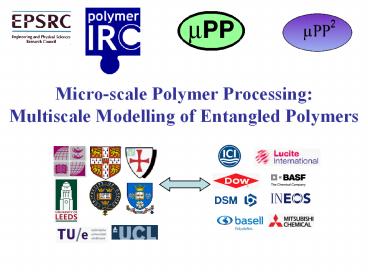Micro-scale Polymer Processing: Multiscale Modelling of Entangled Polymers - PowerPoint PPT Presentation
1 / 19
Title: Micro-scale Polymer Processing: Multiscale Modelling of Entangled Polymers
1
Micro-scale Polymer ProcessingMultiscale
Modelling of Entangled Polymers
2
Polymer Processing in the 21st century?
Reaction Chemistry
Molecular shape
Melt Rheology
Good processing
3
Industrial LCB and the Buffer Zone
INDUSTRIAL RESINS
THEORY
MODEL MATERIALS
4
The Scaffold Concept
INDUSTRY
5
The Principle
- Follow the processing path of well characterised
polymers from synthesis through processing and
property evaluation combined with the parallel
development of a mathematical and computational
protocol.
6
The Team
- Leeds
- Tom McLeish, Oliver Harlen, David Groves, Alexei
Likhtman, Tim Nicholson, Alan Duckett, John
Embery, Jorge Ramirez, Chinmay Das, Harley Klein,
Dietmar Auhl - Bradford
- Phil Coates, Tim Gough, Mike Martyn, Rob Spares
- Durham
- Lian Hutchins, Nigel Clarke, Eduardo de Luca
- Sheffield
- Tony Ryan, Ellen Heeley, Patrick Fairclough, Ron
Young, Christine Fernyhough - Cambridge
- Malcolm Mackley, Karen Lee, Ashish Lele, Mark
Collis, David Hassell - Oxford
- Paul Buckley, Junjie Wu, David de Foccatis
7
Outline
Compression Craze Birefringence
Ox ford Model
Cambridge MPR4/ Bradford-Durham recirc.
flowSolve
Durham SANS Sheffield SAXS
G, shear transients, step shear Mei?ner
extensional
Tube models LCB Pom-Pom linear ROLIEPOLY
hPSdPS linears 3 blends PB combs PB linears
hPB variants
8
Synthesis Platform
- Make polybutadiene in controlled fashion
- Polydispersity lt 1.05
- Molecular weight determined by reagent quantities
- Micro-structure affected by temperature, solvent
- Then hydrogenate to make polyethylene
9
Molecular Theory Platform
Update on tube model physics Reptation Contour
Length Fluctuation Constraint Release
10
Detailed Chain Formulation
Graham, Likhtman, Milner, TCBM
Reptation CLF
flow
CR
retraction
11
Linear shear rheology andpredictions
µPP2 software tool RepTate
Lines are predictions from linear theory
(Likhtman McLeish 2002)
Tref. 25 C
Model Parameters from linear theory (Likhtman
McLeish 2002) ?e (25C) 0.003 s Ge (25C)
0.569 MPa Me 4.86 kg/mol cv 0.1
PI-4k
PI-14k
PI-30k
PI-90k
PI-200k
12
Flow solving Platform
- Constitutive equation can be used to calculate
polymer stress. - Develop a Lagrangian finite element flow solver
whose moving triangular grid elements can hold
the constitutive parameters (orientation and
stretch for each mode).
- Solve momentum and mass conservation
equationswhere ? is the polymeric stress
Nicholson, Bishko, Harlen
13
flowSolve output planar flow
- The recirculating vortex in the corner grows
considerably as the simulation proceeds. - The maximum stretch is not along the centre line,
but lies between the centre line and the
recirculating region where the material is
sheared prior to extension.
14
MuPP2 Structure
A Matrix approach to Industrial demand and
technical opportunity
15
MuPP2 Management
- Special task groups
- Rheology team
- Synthesis team
- Solid State team
- Flow solving software team
- PDRA conference
16
(No Transcript)
17
2PHASE Mesoscale Simulations
Two-dimensional simulations of freely suspended
particles in a polymeric fluid under shear
flow. Biperiodic lattice to extend a unit cell
containing N particles to an infinte domain.
- Under shear these cells slide
- relative to one another.
O. Harlen and A. Malidi
18
CRYSTAL
Shear-induced crystallization of comb 10
sheared at 100 s-1 for 5 s prior to
crystallisation
54 kg mol-1 backbone with 8 arms of 15 kg mol-1
No shear
- Massively increased rates after shear
- Well oriented crystals (no shearing during
crystallisation)
19
Conclusions
- Model materials refine new entanglement physics
- Molecular structure has flow-field consequences
- Chain orientation is a family of numbers
- Routes to Polydisperse architectures
- Methodology extends to product structure in phase
and crystallinity.































